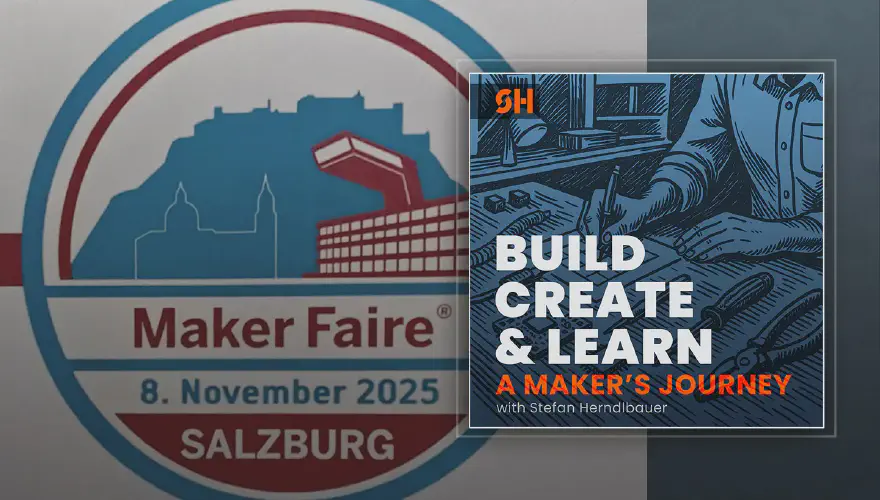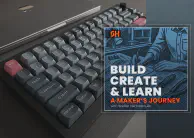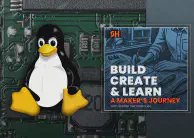From Makers to Hackers – Lessons from Maker Faire Salzburg
After two deeply technical episodes on Embedded Linux and kernel driver development, I wanted to take a breath — to zoom out and look at the bigger picture. So for Episode 10 of Build, Create & Learn – A Maker’s Journey, I did something different: I left the code editor, grabbed my camera, and headed to Maker Faire Salzburg.
What I found there reminded me why I started building things in the first place.
Curiosity Is the Common Thread
Everywhere I looked — kids soldering their first circuit, families assembling robots, students showing university projects — I saw the same spark: curiosity.
Maybe we’re all born makers. Somewhere between childhood and adulthood, we just forget the playful urge to experiment. At the fair, that curiosity was alive and loud: laser engravers buzzing, 3D printers humming, people asking questions and not caring if they got messy answers.
For me, it was a reminder that making isn’t just about tools or skills. It’s a way of seeing the world — asking “what happens if I try this?” and being willing to find out.
Scenes from the Maker Faire
The Salzburg Maker Faire wasn’t huge like Hannover or San Francisco, but it had its own charm. I spent the morning watching children experiment with wood, textiles, and electronics. The joy on their faces was contagious. In another hall, radio enthusiasts were showing antenna projects next to 3D printing collectives, the local Chaos Computer Club, and tool makers.
One table was covered in retro hardware — old 486 PCs and circuit boards that brought me right back to my first encounters with BASIC on MS-DOS. It felt like a full circle moment: the same fascination that made me take apart an alarm clock as a kid is what drives me to explore Linux kernel modules today.
Check out my YouTube video for more impression of the faire:
Makers and Hackers — Two Sides of Curiosity
On the train ride home, a thought kept looping in my head: making and hacking aren’t opposites — they’re reflections. Both are about understanding systems deeply. Both celebrate experimentation, breaking things, and learning from what happens next.
The hacker stereotype — the hooded figure hammering on a keyboard — hides the truth that most hackers are actually researchers, tinkerers, and learners. Just like makers, they’re driven by the desire to explore. The difference lies in intent.

Image by Sandy Flowers from Pixabay
In cybersecurity, we talk about white-hat and black-hat hackers. One tests systems ethically to improve them; the other exploits them for gain. In the maker world, failure and experimentation are openly celebrated — but maybe we could borrow some of that ethical structure from hacking, too.
When I work on hardware or software projects, I realize how valuable it is to understand common vulnerabilities. Knowing how things break helps you design better — safer, smarter, more resilient systems.
Ethical Curiosity
Curiosity has power. But like any power, it depends on how we use it. Ethical curiosity is about exploring to understand, not to exploit. It’s the bridge between creativity and responsibility — the idea that learning how systems fail makes us better at building them.
Imagine if every makerspace had a “hacker corner” — a safe place to learn about IoT security, wireless protocols, or network defense. Imagine if schools taught ethical hacking the same way they teach physics or art: as a method of discovery. Because in the end, hacking and making both start from the same impulse: I wonder what happens if…
Where This Journey Leads Next
This episode marks a small turning point in my second season — from exploring the inner workings of Linux to exploring the mindset that drives discovery.
It also sets the stage for something new: HakFabrik (under construction), my upcoming project that brings together maker culture, cybersecurity, and learning by doing. It’s still early, but the goal is clear — to build tools and experiences that help people learn hacking the same way makers learn electronics: hands-on, creative, and fun.
Closing Thoughts
Curiosity isn’t just the spark that starts a project — it’s the engine that keeps it running. Whether you’re writing kernel code, reverse-engineering a protocol, or helping your kid assemble a toothbrush robot, it all comes from the same place: the desire to understand by exploring.
📬 Subscribe to The Maker’s Logbook
Get weekly behind-the-scenes updates, progress notes, and extra resources:
👉 herndlbauer.com/pages/newsletter
🎧 Listen to the full episode:
Let’s keep building, creating, and learning — together.



